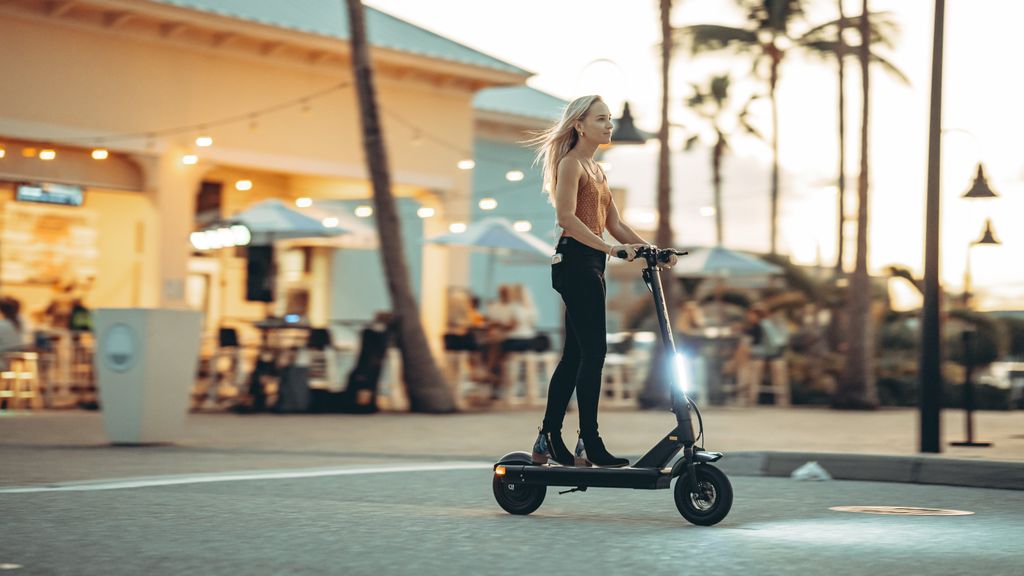Electric scooters have become increasingly popular as a convenient and eco-friendly mode of transportation. With their compact size and electric-powered motors, they offer a practical solution for short-distance travel. However, before making a purchase, it’s important to consider various factors and weigh the pros and cons. In this article, we will explore the key aspects of electric scooters and provide valuable insights to help you determine if an electric scooter is worth buying.
Key Takeaways
- Electric scooters are a convenient and eco-friendly mode of transportation for short distances.
- Factors to consider before buying include range, speed, weight, safety features, and cost.
- Choosing the right electric scooter involves considering intended use, weight capacity, foldability, comfort, and maintenance.
- Pros of owning an electric scooter include cost savings, environmental benefits, and ease of use.
- Cons of owning an electric scooter include limited range, potential safety risks, and maintenance requirements.
What is an Electric Scooter?

How does an Electric Scooter work?
Electric scooters are powered by rechargeable batteries that provide the energy needed to propel the scooter forward. When the rider activates the throttle, the battery sends an electric current to the motor, which then turns the wheels. The motor is typically located near the rear wheel and is responsible for converting the electrical energy into mechanical energy. This allows the scooter to move at varying speeds depending on the power output of the motor.
Unlike traditional scooters that require manual propulsion, electric scooters offer a convenient and effortless mode of transportation. The battery-powered motor eliminates the need for constant kicking or pedaling, making it easier for riders to travel longer distances without exerting too much effort. Additionally, electric scooters often come with adjustable speed settings, allowing riders to choose their desired speed for a comfortable and controlled ride.
Benefits of using an Electric Scooter
Using an electric scooter offers several benefits that make it a popular choice for transportation. Convenience is one of the key advantages of electric scooters. They are compact and lightweight, making them easy to maneuver through traffic and navigate crowded city streets. Additionally, electric scooters are environmentally friendly as they produce zero emissions, helping to reduce air pollution and carbon footprint. Another benefit is the cost savings. Electric scooters are more affordable to operate compared to traditional vehicles, as they require less maintenance and have lower fuel costs. Moreover, electric scooters are quiet and produce minimal noise pollution, making them a great option for urban areas where noise reduction is important.
In terms of safety, electric scooters are equipped with features such as brakes, lights, and reflectors to ensure visibility and enhance rider safety. Some models also have suspension systems to provide a smoother ride and reduce the impact of bumps and uneven surfaces. Additionally, many electric scooters have speed control options, allowing riders to adjust their speed according to the road conditions and their comfort level.
Overall, using an electric scooter offers a convenient, eco-friendly, cost-effective, and safe mode of transportation.
Types of Electric Scooters
There are several types of electric scooters available in the market, each designed for different purposes and user preferences. Here are some common types of electric scooters:
-
Foldable Electric Scooters: These scooters are compact and easy to carry, making them ideal for commuters who need to travel short distances and have limited storage space.
-
Off-Road Electric Scooters: Built with rugged tires and powerful motors, off-road electric scooters are designed to handle rough terrains and provide a thrilling riding experience.
-
Three-Wheel Electric Scooters: These scooters offer enhanced stability and balance, making them a popular choice for individuals with mobility issues or those who prefer a more comfortable ride.
-
Electric Kick Scooters: Lightweight and portable, electric kick scooters are perfect for urban commuting and navigating through crowded streets.
When choosing an electric scooter, it’s important to consider your intended use and terrain to ensure you select the right type that suits your needs.
Factors to Consider Before Buying an Electric Scooter

Range and Battery Life
When considering an electric scooter, one of the most important factors to evaluate is its range and battery life. The range refers to the distance the scooter can travel on a single charge, while battery life refers to how long the battery will last before needing to be recharged. These factors are crucial in determining the practicality and usability of an electric scooter.
To make an informed decision, it’s essential to consider your daily commuting needs. If you plan to use the scooter for short trips or within a limited range, a scooter with a lower range may be sufficient. However, if you require a scooter for longer commutes or extended outdoor adventures, it’s advisable to opt for a model with a higher range and longer battery life.
Here are a few key points to keep in mind when evaluating the range and battery life of an electric scooter:
- Charging Time: Consider how long it takes to fully charge the battery. Some scooters may require several hours to charge, while others offer fast-charging capabilities.
- Battery Type: Different scooters use various battery technologies, such as lithium-ion or lead-acid. Lithium-ion batteries are generally more efficient and provide longer-lasting power.
- Terrain and Riding Conditions: Keep in mind that the range and battery life can vary depending on the terrain and riding conditions. Uphill climbs, rough surfaces, and higher speeds can drain the battery faster.
By carefully evaluating the range and battery life of an electric scooter, you can ensure that it meets your specific needs and provides a reliable and convenient mode of transportation.
Speed and Power
When considering the speed and power of an electric scooter, it is important to understand that these factors can vary significantly depending on the model. Some electric scooters are designed for speed and can reach top speeds of up to 30 mph or more, while others are more focused on providing a comfortable and stable ride at lower speeds.
In terms of power, electric scooters typically have motors with wattage ratings ranging from 250W to 1000W or more. Higher wattage motors generally provide more torque and acceleration, allowing the scooter to handle inclines and uneven terrain more effectively.
It is important to consider your specific needs and preferences when evaluating the speed and power of an electric scooter. If you plan to use the scooter for commuting or traveling longer distances, a higher top speed and more powerful motor may be desirable. On the other hand, if you primarily need a scooter for short trips or leisurely rides, a lower top speed and less powerful motor may be sufficient.
Here are some key points to consider when evaluating the speed and power of an electric scooter:
- Top speed: Determine the maximum speed the scooter can reach and whether it aligns with your intended use.
- Motor power: Consider the wattage rating of the motor and how it affects the scooter’s performance.
- Acceleration: Look for information on the scooter’s acceleration capabilities, as this can impact how quickly it can reach its top speed.
- Terrain compatibility: Evaluate whether the scooter can handle the types of terrain you will encounter, such as hills or rough surfaces.
Keep these factors in mind when assessing the speed and power of an electric scooter to ensure you choose a model that meets your needs and provides an enjoyable riding experience.
Weight and Portability
When considering an electric scooter, weight and portability are important factors to take into account. A lighter scooter is easier to carry and transport, making it more convenient for daily commuting or traveling. Additionally, a scooter with foldable features allows for compact storage and easy transportation in crowded spaces or public transportation. Portability is especially crucial for individuals who need to navigate stairs or have limited storage space. However, it’s important to note that lighter scooters may sacrifice some stability and durability compared to heavier models. Therefore, it’s essential to find a balance between weight and sturdiness that suits your specific needs and preferences.
In terms of portability, some electric scooters come with additional features such as carrying handles or detachable batteries, which can enhance convenience and ease of use. These features make it easier to transport the scooter when it’s not in use or when the battery needs to be charged. Foldability is another aspect to consider, as it allows for easier storage in small spaces like apartments or offices. Some scooters even have a one-click folding mechanism, making it quick and effortless to fold and unfold the scooter as needed.
To summarize, when evaluating electric scooters, it’s crucial to consider the weight and portability of the scooter. Look for a scooter that strikes a balance between being lightweight and sturdy, and consider additional features like foldability and detachable batteries for added convenience.
Safety Features
When considering an electric scooter, safety features are an important factor to take into account. These features are designed to ensure a safe and secure riding experience. Some common safety features found in electric scooters include:
- LED lights: Electric scooters are equipped with bright LED lights that enhance visibility, especially during nighttime rides.
- Brakes: Most electric scooters come with reliable braking systems, such as disc brakes or regenerative braking, which allow for quick and efficient stopping.
- Suspension: Some electric scooters are equipped with suspension systems that help absorb shocks and provide a smoother ride.
- Anti-lock braking system (ABS): This feature prevents the wheels from locking up during sudden braking, reducing the risk of accidents.
It is important to choose an electric scooter that has these safety features to ensure a safe and enjoyable riding experience.
Cost and Value for Money
When considering the cost and value for money of an electric scooter, it’s important to look beyond the initial purchase price. While electric scooters may have a higher upfront cost compared to traditional scooters, they offer several long-term cost-saving benefits. Maintenance costs for electric scooters are generally lower as they have fewer moving parts and don’t require regular oil changes or tune-ups. Additionally, fuel costs are significantly reduced as electric scooters run on electricity, which is cheaper than gasoline. Over time, these savings can offset the initial investment and make electric scooters a cost-effective choice.
Another factor to consider is the resale value of an electric scooter. As technology advances and more people embrace electric transportation, the demand for used electric scooters is expected to increase. This means that if you decide to upgrade or no longer need your electric scooter, you may be able to sell it at a good price, further enhancing its value for money.
In summary, while electric scooters may have a higher upfront cost, their lower maintenance and fuel costs, as well as potential resale value, make them a worthwhile investment in the long run.
Choosing the Right Electric Scooter for Your Needs

Intended Use and Terrain
When choosing an electric scooter, it is important to consider your intended use and the terrain you will be riding on. Electric scooters are designed for various purposes, including commuting, leisure, and off-road adventures. If you plan to use your scooter for daily commuting, you may want to prioritize features such as speed, range, and portability. On the other hand, if you are looking for a scooter for off-road use, you will need one with rugged tires and a powerful motor to handle uneven terrain. It is essential to match the scooter’s capabilities with your specific needs to ensure a safe and enjoyable riding experience.
Weight Capacity
When considering the weight capacity of an electric scooter, it is important to choose a scooter that can comfortably support your weight. The weight capacity refers to the maximum weight that the scooter can safely carry. Exceeding the weight capacity can affect the scooter’s performance and may lead to safety issues. It is recommended to choose a scooter with a weight capacity that is higher than your actual weight to ensure optimal performance and safety.
Here are some factors to consider when evaluating the weight capacity of an electric scooter:
- User weight: Determine your weight and choose a scooter with a weight capacity that can accommodate your weight.
- Payload capacity: Consider any additional items or bags that you may carry while riding the scooter.
- Stability: A scooter with a higher weight capacity tends to be more stable and can provide a smoother ride.
It is important to note that exceeding the weight capacity of the scooter can void the warranty and may result in damage to the scooter. Always refer to the manufacturer’s guidelines and recommendations regarding weight capacity and usage limits.
Foldability and Storage
When considering an electric scooter, one important factor to keep in mind is its foldability and storage capabilities. Foldability allows for easy transportation and storage, making it convenient for those who need to carry their scooter on public transportation or store it in small spaces. Some scooters have a simple folding mechanism that allows them to be quickly folded and unfolded, while others may require more time and effort. It’s important to consider the size and weight of the scooter when folded, as well as how easily it can be carried or wheeled when not in use.
In terms of storage, it’s important to have a designated space to keep your electric scooter when it’s not in use. This can help protect it from damage and prolong its lifespan. Some scooters come with built-in storage compartments or hooks for hanging, while others may require additional accessories or storage solutions. It’s also worth considering whether the scooter can be stored upright or if it needs to be laid flat. Overall, the foldability and storage capabilities of an electric scooter can greatly impact its convenience and practicality for everyday use.
Comfort and Ride Quality
When it comes to comfort and ride quality, an electric scooter should provide a smooth and enjoyable experience for the rider. The suspension system plays a crucial role in absorbing shocks and vibrations, ensuring a comfortable ride even on uneven surfaces. Additionally, the quality of the tires can greatly impact the ride quality. Pneumatic tires, with their air-filled design, offer better shock absorption and grip compared to solid tires. Durability is also an important factor to consider, as a well-built scooter will provide a more stable and comfortable ride over time.
To enhance the riding experience, some electric scooters come with adjustable handlebars and seats. This allows riders to customize the scooter to their preferred height and position, reducing strain on the body during longer rides. Ergonomics is an important consideration for riders who value comfort and want to avoid fatigue.
In summary, when choosing an electric scooter, it’s important to prioritize comfort and ride quality. Look for features such as a suspension system, quality tires, and adjustable components to ensure a smooth and enjoyable ride.
Maintenance and Warranty
When considering the maintenance and warranty of an electric scooter, it is important to understand the manufacturer’s guidelines and recommendations. Regular maintenance, such as checking tire pressure, cleaning the scooter, and inspecting the brakes, can help ensure optimal performance and longevity.
Additionally, it is crucial to review the warranty provided by the manufacturer. The warranty may cover certain components or repairs for a specific period of time. It is advisable to carefully read the terms and conditions of the warranty to understand what is included and any limitations or exclusions.
To keep your electric scooter in good condition, here are some maintenance tips:
- Keep the scooter clean and free from dirt and debris.
- Regularly check the tire pressure and inflate as needed.
- Inspect the brakes and replace worn brake pads.
- Lubricate moving parts, such as the folding mechanism and handlebars.
- Store the scooter in a dry and secure location when not in use.
Remember, proper maintenance can help extend the lifespan of your electric scooter and ensure a safe and enjoyable riding experience.
Pros and Cons of Owning an Electric Scooter

Advantages of Electric Scooters
Electric scooters offer several advantages over traditional scooters and other modes of transportation. One of the main benefits is their eco-friendliness. Electric scooters produce zero emissions, making them a greener alternative to gas-powered vehicles. They also have lower operating costs since they don’t require gasoline. Additionally, electric scooters are quieter and produce less noise pollution compared to traditional scooters.
Another advantage of electric scooters is their convenience. They are compact and lightweight, making them easy to maneuver in crowded urban areas. Electric scooters also have a quick acceleration, allowing riders to navigate through traffic more efficiently. They can be parked in small spaces and are often foldable, making them portable and easy to store.
Furthermore, electric scooters are cost-effective. They have lower maintenance costs compared to gas-powered scooters since they have fewer moving parts and don’t require oil changes. Electric scooters also have a longer lifespan and are more durable. They are also cheaper to operate, with lower electricity costs compared to gasoline expenses.
In summary, electric scooters offer environmental benefits, convenience, and cost savings. They are a practical and sustainable mode of transportation for short commutes and urban travel.
Disadvantages of Electric Scooters
While electric scooters offer numerous benefits, there are also some disadvantages to consider. One major drawback is the limited range and battery life. Most electric scooters have a range of around 15-30 miles, which may not be sufficient for longer commutes or trips. Additionally, the battery life can vary depending on factors such as speed, terrain, and rider weight.
Another disadvantage is the speed and power limitations of electric scooters. While they are convenient for short distances, they may not be suitable for high-speed travel or steep inclines. Electric scooters typically have a top speed of around 15-20 mph, which may not be fast enough for some riders.
Weight and portability can also be a concern with electric scooters. Some models can be heavy and difficult to carry, especially if you need to navigate stairs or public transportation. It’s important to consider the weight of the scooter and whether it can be easily folded or stored when not in use.
Lastly, safety features may be lacking in some electric scooters. While many models have basic safety features such as lights and brakes, they may not offer advanced features like suspension or anti-lock braking systems. It’s important to prioritize safety when choosing an electric scooter.
Overall, electric scooters have their advantages, but it’s important to consider these disadvantages before making a purchase decision.
Tips for Buying an Electric Scooter

Research and Compare
When researching and comparing electric scooters, it’s important to consider a few key factors. First, take a look at the scooter’s range and battery life. This will determine how far you can travel on a single charge and how long the scooter will last before needing to be recharged. Next, consider the speed and power of the scooter. A higher speed and more powerful motor will allow you to reach your destination faster and tackle inclines with ease. Additionally, think about the weight and portability of the scooter. If you plan on carrying it around or storing it in a small space, a lightweight and foldable scooter may be more convenient. Finally, don’t forget to check the safety features of the scooter, such as brakes and lights, to ensure a safe riding experience. By comparing these factors, you can find the electric scooter that best suits your needs and preferences.
Test Ride Before Buying
Before purchasing an electric scooter, it is highly recommended to take it for a test ride. This allows you to get a feel for the scooter’s performance, handling, and comfort. During the test ride, pay attention to the scooter’s acceleration, braking, and maneuverability. Make sure to test it on different terrains such as flat surfaces, inclines, and rough roads to see how it performs in various conditions. Additionally, take note of the scooter’s stability and how it handles turns. By test riding the electric scooter, you can ensure that it meets your expectations and suits your riding style.
Consider Long-Term Costs
When considering the purchase of an electric scooter, it’s important to take into account the long-term costs associated with owning one. While electric scooters are generally more cost-effective than traditional gas-powered scooters, there are still some expenses to consider.
One of the main long-term costs is the battery replacement. Electric scooter batteries have a limited lifespan and will eventually need to be replaced. The cost of a new battery can vary depending on the brand and model of the scooter, but it’s important to factor this expense into your budget.
Another cost to consider is maintenance and repairs. Like any vehicle, electric scooters require regular maintenance to keep them running smoothly. This can include things like tire replacements, brake adjustments, and general upkeep. It’s important to budget for these expenses to ensure the longevity of your scooter.
Additionally, it’s worth considering the cost of charging your electric scooter. While charging costs are generally low compared to fuel costs for gas-powered scooters, it’s still important to factor this into your overall budget. Depending on your usage and the cost of electricity in your area, charging your scooter on a regular basis can add up over time.
To make sure you’re getting the most value for your money, it’s a good idea to compare the long-term costs of different electric scooter models. Consider factors such as battery life, maintenance requirements, and charging costs to determine which scooter offers the best long-term value.
Overall, while electric scooters can provide a cost-effective and eco-friendly mode of transportation, it’s important to consider the long-term costs before making a purchase decision.
Read Reviews and User Feedback
When considering purchasing an electric scooter, it is important to take the time to read reviews and user feedback. This can provide valuable insights into the performance, reliability, and overall satisfaction of the scooter. Look for reviews from reputable sources and consider both positive and negative feedback. Pay attention to common themes or issues mentioned by users, as this can help you make an informed decision. Additionally, user feedback can provide information on specific features or functionalities that may be important to you, such as battery life, speed, or ease of use. Taking the time to research and consider reviews and user feedback can help ensure that you choose an electric scooter that meets your needs and expectations.
Check Local Laws and Regulations
When considering purchasing an electric scooter, it is crucial to be aware of the local laws and regulations regarding their use. Different cities and countries may have specific rules in place regarding where and how electric scooters can be ridden. Some areas may require riders to wear helmets or have a valid driver’s license, while others may have restrictions on riding in certain areas or on sidewalks. It is important to research and understand the local laws and regulations before buying an electric scooter to ensure that you can use it safely and legally in your area.
Here are a few tips to keep in mind:
- Check if there are any age restrictions for riding electric scooters.
- Find out if there are designated bike lanes or paths where electric scooters are allowed.
- Look into any specific speed limits or restrictions on riding in certain areas.
- Familiarize yourself with any requirements for safety equipment, such as helmets or lights.
By being aware of and following the local laws and regulations, you can enjoy your electric scooter responsibly and avoid any potential legal issues.
Conclusion
In conclusion, electric scooters offer a convenient and eco-friendly mode of transportation. They are ideal for short commutes and can save you time and money. With their compact size and easy maneuverability, electric scooters are perfect for navigating crowded city streets. Additionally, their low maintenance and operating costs make them a cost-effective option. While there are some limitations, such as limited range and charging infrastructure, the benefits of owning an electric scooter outweigh the drawbacks. So, if you are looking for a practical and efficient way to get around, consider investing in an electric scooter.
Frequently Asked Questions
Are electric scooters safe to ride?
Yes, electric scooters are generally safe to ride. However, it is important to follow safety guidelines and wear protective gear such as helmets, knee pads, and elbow pads. It is also crucial to be aware of your surroundings and follow traffic rules.
How far can an electric scooter go on a single charge?
The range of an electric scooter depends on various factors such as the battery capacity, the weight of the rider, the terrain, and the speed. On average, most electric scooters can travel between 15 to 30 miles on a single charge.
How long does it take to charge an electric scooter?
The charging time of an electric scooter depends on the battery capacity and the charger used. In general, it takes around 4 to 8 hours to fully charge an electric scooter. Some models may have fast-charging capabilities and can charge in as little as 2 hours.
Can I ride an electric scooter in the rain?
While some electric scooters are designed to be water-resistant, it is generally not recommended to ride them in heavy rain or through deep puddles. Water can damage the electrical components of the scooter and affect its performance. It is best to avoid riding in wet conditions and to always check the manufacturer’s guidelines.
Do I need a license to ride an electric scooter?
The requirements for riding an electric scooter vary depending on the location. In some areas, a driver’s license or a special permit may be required. It is important to check the local laws and regulations regarding electric scooter usage before riding one.
How much does an electric scooter cost?
The cost of an electric scooter can vary depending on the brand, model, features, and specifications. On average, electric scooters can range from $300 to $2000. It is important to consider the quality, durability, and warranty when determining the value for money.




